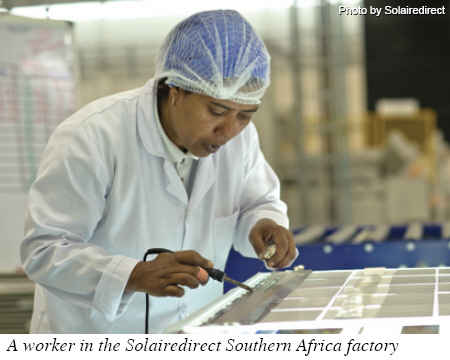By Ryan Hammond

 The current situation in South Africa is that electricity tariffs are increasing rapidly to close the price gap--an average of 25% a year for the next three years. There is a coal-fired build program underway (the Medupi and Kusile power stations with +/- 4400MW net output each) as part of the South African public utility body, Eskom’s expansion, but current tariffs do not allow real cost recovery. The current situation in South Africa is that electricity tariffs are increasing rapidly to close the price gap--an average of 25% a year for the next three years. There is a coal-fired build program underway (the Medupi and Kusile power stations with +/- 4400MW net output each) as part of the South African public utility body, Eskom’s expansion, but current tariffs do not allow real cost recovery.
Around 90% of South Africa’s electricity is generated by ESKOM--of this much comes from coal-fired power stations built in the 1970s and 1980s. Very little base load capacity has been delivered since the last major build programs about 20 years ago, and reserve margins have slipped below internationally accepted norms of 15-20%.
An abundance of cheap coal, an oversupply of generation capacity during the apartheid era and below inflation tariff increases over many years has resulted in a South Africa having one of the world’s cheapest electricity prices--of less than six US cents per kilowatt hour.
By 2013, South Africans will be paying on average more than R1/kWh for electricity. Meanwhile, the average price of PV modules has halved since 2008.
Currently, the average annual solar resource available across most of Southern Africa averages 2,000 kWh/m2. The possible load factor for a solar PV installation in this part of the world is 25-30%, with 90% supply predictability.
South Africa’s Renewable Energy Feed-in Tariff (Refit)
After the announcement of The National Energy Regulator (Nersa) of South Africa’s Renewable Energy Feed-in Tariff (Refit) program, a reforming regulatory environment which will facilitate Independent Power Production of both ‘brown’ and renewable energy exists.
Nersa began a study on a Refit in 2007 in response to the government target of 10,000 GWh from renewable sources by 2013. The Refit Phase One consultation paper was issued in December 2008, with hearings in early 2009. The Refit Phase One guideline document was approved and published by NERSA in March 2009 but a tariff for PV systems (less than 1 MW) of R4.48/kWh was only included in the Refit Phase Two consultation paper in July 2009. The Refit Phase Two guideline document was approved and published by Nersa in October last year, with the final PV tariff at R3.94/kWh.
In February, the Refit Project Selection Criteria paper was published, which contained proposed caps on various technologies per year from 2011 to 2013. PV was included under ‘Other Refit Phase 2’ technologies, with an indicative cap of 150 MW per annum.
Various public consultations were held and interested parties were invited to submit written submissions, however, no further written correspondence has been published.
Smunda Mokena, CEO of Nersa, briefed the Parliamentary Monitoring Committee in August, confirming that tariffs would be indexed to the Consumer Price Index and reviewed every year for the first five years, and every third year thereafter. He also said power purchase agreements would stand for a period of 20 years, with independent power producers retaining all rights to all Clean Development Mechanism benefits. Mokena said, “Nersa are finalizing the Selection Criteria rules and would shortly submit the finalized document to the Department of Energy and National Treasury for approval.” In addition, Mokena said Nersa anticipated the System Operator or buyer would issue a Request for Qualification and shortly, thereafter, a Request for Proposals from qualified bidders--a process he was confident would start before the end of 2010.
Africa’s Independent Power Generation
Looking forward for South Africa’s renewable energy program, we can expect an extensive public consultation process to have taken place with fully modeled base case scenarios completed and the final draft of Integrated Resource Planning 2 expected to be promulgated by the end of 2010.
It is understood that the initial base case being considered for renewable energy is; Wind: 500 MW by 2013, 1000 MW per annum thereafter; CSP: 500 MW per annum from 2018; and PV: 100 MW per annum from 2018. This is subject to further consideration and, of course, lobbying from the photovoltaic sector.
However, in South Africa the long legislative process to make independent power generation is complete. The implementation of a capped feed-in tariff system is expected by the end of this year and in the short term the photovoltaic market is expected to be around 100 MW per year, with the mid to long terms numbers likely to be higher.
The advantages of solar photovoltaics are that as energy demand rises, it is quick to deploy, with construction times less than other forms of renewable energy. It offers predictable output from proven technology; it is flexible in terms of plant size and location making it suitable for grid network integration. The environmental impact is minimal, with no reliance on any fuel source except the sun and the majority of the parts recyclable at the end of their working life, the CO2 output decreases dramatically. Operation and maintenance costs are minimal, with no need for fuel or water to run.

Solar Advantages to Local Development
Renewable companies in South Africa are lobbying government, building links with business and labor organizations and informing people of the economic and environmental benefits of using green energy for electricity generation. But are they contributing to the country’s economic uplift?
Investment in renewable energy and energy efficiency is important to reduce the negative economic, social and environmental impacts of energy production and consumption in South Africa, but while many companies are talking about investing, Solairedirect Southern Africa has put their money where their mouth is.
The government has stated that it wants to see a greater investment by the private sector in independent and, more specifically, renewable power producers, but to what extent will South Africa’s working class benefit from this?
It would be a great pity if the Refit program simply served to provide foreign companies with a new market for their products. I have no doubt South African government has the intention to use this program to stimulate a local renewable industry, but if not managed correctly, it may simply help create and/or protect manufacturing jobs in foreign countries, rather than stimulate their creation in South Africa.
If you take the example of how the Indian government is going about implementing renewable energy policy, they demand a minimum local content in order to qualify for incentives when it comes to the solar PV sector, thereby ensuring that incentives paid for by the Indian government, and indirectly by the Indian people, result in job creation for the Indian people. While I believe this stance is too extreme in South Africa, given the limited local production capacity, we would certainly like to see projects that use locally produced products given preference over those who import.
Ryan Hammond is the managing director of Solairedirect Southern Africa, a vertically integrated power producer providing a turnkey solar power generation service. Based in Cape Town, the company develops, designs, builds, owns and operates solar PV power plants. Solairedirect, with headquarters in France, had a 2009 turnover of more than 70 million and looks set to achieve a 2010 turnover of about 150 million.
For more information, please send your e-mails to pved@infothe.com.
ⓒ2010 www.interpv.net All rights reserved. |



